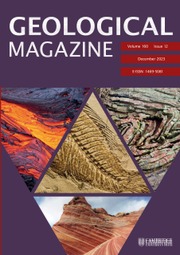Crossref Citations
This article has been cited by the following publications. This list is generated based on data provided by
Crossref.
Osborn, H. F.
1902.
Recent Zoopaleontology.
Science,
Vol. 16,
Issue. 409,
p.
713.
Dart, Ray‐mond A.
and
Andrrws, C. W.
1923.
33. The Brain of the Zeuglodonlidæ (Cetacea).
Proceedings of the Zoological Society of London,
Vol. 93,
Issue. 3,
p.
615.
COURT, NICHOLAS
1994.
The periotic of Moeritherium (Mammalia, Proboscidea): homology or homoplasy in the ear region of Tethytheria McKenna, 1975?.
Zoological Journal of the Linnean Society,
Vol. 112,
Issue. 1-2,
p.
13.
Bajpai, Sunil
and
Domning, Daryl P.
1997.
A new dugongine sirenian from the early Miocene of India.
Journal of Vertebrate Paleontology,
Vol. 17,
Issue. 1,
p.
219.
Bajpai, Sunil
Thewissen, J. G. M.
Kapur, Vivesh Vir
Tiwari, B. N.
and
Sahni, Ashok
2006.
Eocene and Oligocene sirenians (Mammalia) from Kachchh, India.
Journal of Vertebrate Paleontology,
Vol. 26,
Issue. 2,
p.
400.
Stevens, Nancy J.
Gottfried, Michael D.
Roberts, Eric M.
Kapilima, Saidi
Ngasala, Sifa
and
O’Connor, Patrick M.
2008.
Elwyn Simons: A Search for Origins.
p.
159.
Samonds, Karen E.
Zalmout, Iyad S.
Irwin, Mitchell T.
Krause, David W.
Rogers, Raymond R.
and
Raharivony, Lydia L.
2009.
Eotheroides lambondrano, new middle Eocene seacow (Mammalia, Sirenia) from the Mahajanga Basin, northwestern Madagascar.
Journal of Vertebrate Paleontology,
Vol. 29,
Issue. 4,
p.
1233.
Hautier, Lionel
Sarr, Raphaël
Tabuce, Rodolphe
Lihoreau, Fabrice
Adnet, Sylvain
Domning, Daryl P.
Samb, Momar
and
Hameh, Pierre Marwan
2012.
First prorastomid sirenian from Senegal (Western Africa) and the Old World origin of sea cows.
Journal of Vertebrate Paleontology,
Vol. 32,
Issue. 5,
p.
1218.
Zouhri, Samir
Gingerich, Philip D.
Elboudali, Najia
Sebti, Samira
Noubhani, Abdelmajid
Rahali, Meriem
and
Meslouh, Saïd
2014.
New marine mammal faunas (Cetacea and Sirenia) and sea level change in the Samlat Formation, Upper Eocene, near Ad-Dakhla in southwestern Morocco.
Comptes Rendus Palevol,
Vol. 13,
Issue. 7,
p.
599.
Voss, Manja
2014.
On the invalidity of Halitherium schinzii Kaup, 1838 (Mammalia, Sirenia), with comments on systematic consequences.
Zoosystematics and Evolution,
Vol. 90,
Issue. 1,
p.
87.
Balaguer, Jordi
and
Alba, David M.
2016.
A new dugong species (Sirenia, Dugongidae) from the Eocene of Catalonia (NE Iberian Peninsula).
Comptes Rendus Palevol,
Vol. 15,
Issue. 5,
p.
489.
Velez-Juarbe, Jorge
and
Wood, Aaron R.
2018.
An early Miocene dugongine (Sirenia: Dugongidae) from Panama.
Journal of Vertebrate Paleontology,
Vol. 38,
Issue. 5,
p.
e1511799.
Tabuce, Rodolphe
Sarr, Raphaël
Adnet, Sylvain
Lebrun, Renaud
Lihoreau, Fabrice
Martin, Jeremy E.
Sambou, Bernard
Thiam, Mustapha
and
Hautier, Lionel
2020.
Filling a gap in the proboscidean fossil record: a new genus from the Lutetian of Senegal.
Journal of Paleontology,
Vol. 94,
Issue. 3,
p.
580.
Díaz-Berenguer, Ester
Houssaye, Alexandra
Badiola, Ainara
and
Canudo, José Ignacio
2020.
The Hind Limbs of Sobrarbesiren cardieli (Eocene, Northeastern Spain) and New Insights into the Locomotion Capabilities of the Quadrupedal Sirenians.
Journal of Mammalian Evolution,
Vol. 27,
Issue. 4,
p.
649.
Heritage, Steven
and
Seiffert, Erik R.
2022.
Total evidence time-scaled phylogenetic and biogeographic models for the evolution of sea cows (Sirenia, Afrotheria).
PeerJ,
Vol. 10,
Issue. ,
p.
e13886.
Kampouridis, Panagiotis
Hartung, Josephina
and
Augustin, Felix J.
2023.
The Phanerozoic Geology and Natural Resources of Egypt.
p.
373.

